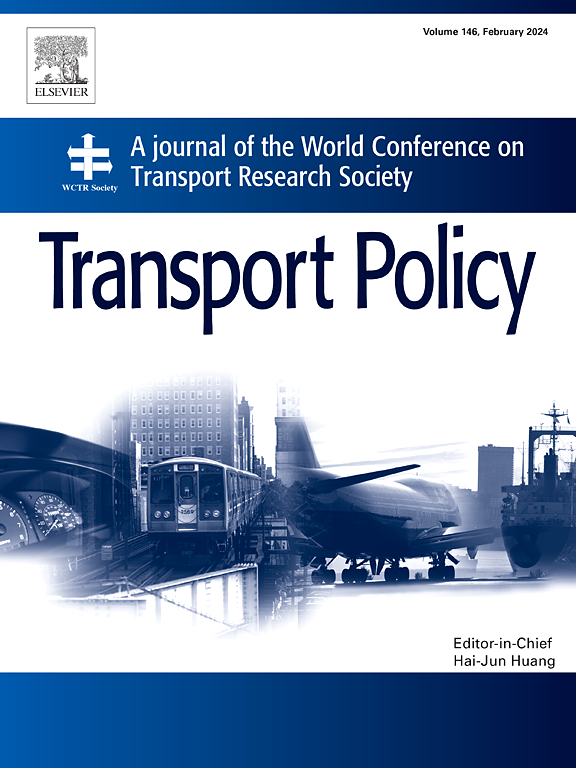Unraveling the dynamics of China railway express (CRE) in China: A multi-method analysis
IF 6.3
2区 工程技术
Q1 ECONOMICS
引用次数: 0
Abstract
As a flagship project of the Belt and Road Initiative (BRI), the China Railway Express (CRE) has significantly reshaped Eurasian trade dynamics through transcontinental rail connectivity. However, systematic quantitative analysis of its spatiotemporal evolution and the heterogeneous drivers behind its development remain understudied. This study utilizes a unique monthly panel dataset from 2013 to 2021, covering involved provinces, and employs an integrated methodology to examine the CRE's evolving patterns and drivers. The key findings include: (1) Spatial econometric analysis reveals distinct cargo flow patterns—outgoing shipments diffuse from northeastern and coastal regions toward central and western hubs, while incoming flows shift from central and eastern China toward southwestern and western regions, establishing the central and western provinces as key nodes in bidirectional logistics networks. (2) Regression analysis identifies a set of significant driving factors, this set of factors is further excavated through DeepAR forecasting and 50 iterations of Permutation Feature Importance (PFI), which uncovers region-specific drivers: outgoing flows are predominantly influenced by policy interventions and supply-side factors (e.g., infrastructure and government attention), while incoming flows are driven by demand-side forces (e.g., consumer markets and informatization level). Coastal areas exhibit a substitution effect with sea-rail transport. Based on these PFI results, targeted recommendations for regional policy differentiation are proposed. (3) Wavelet coherence analysis reveals a dynamic evolution in the relationship between government policy attention and cargo flow volumes, signifying a shift from active governmental engagement towards more passive facilitation. Methodologically, this study introduces a novel analytical framework integrating spatiotemporal pattern analysis, machine learning-driven explainable artificial intelligence (XAI) for driver decomposition, and policy response assessment. Practically, it provides actionable recommendations for tailored regional strategies and offers a replicable methodological blueprint for optimizing multi-regional rail freight systems.
揭示中国铁路快运(CRE)的动态:多方法分析
作为“一带一路”倡议的旗舰项目,中铁班列通过横贯大陆的铁路互联互通,极大地改变了欧亚贸易格局。然而,对其时空演变及其异质性驱动因素的系统定量分析仍有待研究。本研究利用了2013年至2021年的月度面板数据集,涵盖了相关省份,并采用综合方法研究了CRE的演变模式和驱动因素。研究发现:(1)空间计量分析揭示了不同的货流模式——出口货流从东北和沿海地区向中西部枢纽扩散,进口货流从中东部向西南和西部地区转移,中西部省份成为双向物流网络的关键节点。(2)回归分析确定了一组显著驱动因素,并通过DeepAR预测和50次排列特征重要性(PFI)迭代进一步挖掘了这组驱动因素,揭示了区域驱动因素:流出主要受政策干预和供给侧因素(如基础设施和政府关注)的影响,而流入主要受需求侧因素(如消费市场和信息化水平)的影响。沿海地区表现出海铁运输的替代效应。基于这些PFI结果,提出了有针对性的区域政策差异化建议。(3)小波相干分析揭示了政府政策关注与货运量之间的动态演化关系,表明政府从主动参与向被动促进转变。在方法上,本研究引入了一个新的分析框架,将时空模式分析、机器学习驱动的可解释人工智能(XAI)用于驾驶员分解和政策响应评估相结合。实际上,它为量身定制的区域战略提供了可行的建议,并为优化多区域铁路货运系统提供了可复制的方法蓝图。
本文章由计算机程序翻译,如有差异,请以英文原文为准。
求助全文
约1分钟内获得全文
求助全文
来源期刊

Transport Policy
Multiple-
CiteScore
12.10
自引率
10.30%
发文量
282
期刊介绍:
Transport Policy is an international journal aimed at bridging the gap between theory and practice in transport. Its subject areas reflect the concerns of policymakers in government, industry, voluntary organisations and the public at large, providing independent, original and rigorous analysis to understand how policy decisions have been taken, monitor their effects, and suggest how they may be improved. The journal treats the transport sector comprehensively, and in the context of other sectors including energy, housing, industry and planning. All modes are covered: land, sea and air; road and rail; public and private; motorised and non-motorised; passenger and freight.
 求助内容:
求助内容: 应助结果提醒方式:
应助结果提醒方式:


